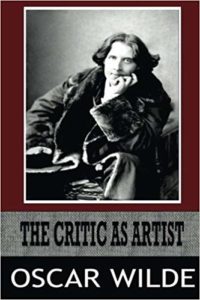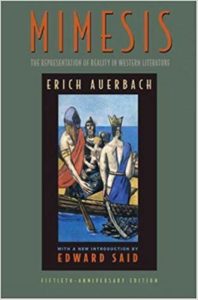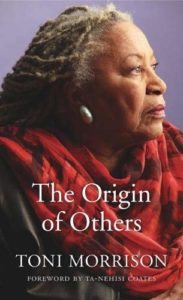
Daniel Mendelsohn’s Ecstasy and Terror is published today. He shares five books about criticism.

The Critic As Artist by Oscar Wilde (1891)
This extended essay of 1891 can be thought of as the beginning of modern criticism: adopting the Platonic form of a dialogue, Wilde advocates the idea of criticism as an artistic undertaking separate from the other arts, one which, because of its emphasis on perspective, subjectivity, and its disdain for sentimental and emotional considerations such as fairness or sympathy, is crucial to modernity.
Jane Ciabattari: How has The Critic as Artist influenced your own thinking as a critic? (Any connection between Wilde’s work and your own “A Critic’s Manifesto?”)
Daniel Mendelsohn: Part of Wilde’s argument is that criticism is not ancillary or parasitic but is an artistic genre in its own right: a stance I take very seriously and have continually argued for myself, not least in my “Critic’s Manifesto.” His prescient emphasis on the vital role that a detached (yet not unfeeling) criticism must play in the life of the culture, as well as his distrust of sentiment, anticipate vital elements of modernism that wouldn’t blossom until after he was dead. (As for artistry, in The Critic As Artist, he puts his money where his mouth is by creating a formally ‘artistic’ work: in fact, the dialogue form is a nod to Plato, with whom of course Wilde, as a precocious classics scholar, was very familiar.) The culture that takes criticism seriously is a culture that understands the dangers of mushy thinking, of mindless cheerleading, of the powerful gravitational force exerted by commerce and marketing. So it is very serious business indeed, and I’m always taken aback in interviews when they treat critical writing as some kind of day job that I canoodle around with when I’m not doing my “real” writing—i.e., the memoirs and narrative nonfiction. Nothing is more “real” to me than my work as a critic.

Anatomy of Criticism by Northrop Frye (1931)
Although Frye’s assumptions about universal categories of literary production fell into disrepute after the rise of Poststructuralism, his Anatomy is impressive and remains essential for its commanding articulation of a unified theory of criticism: its “scope, theory, principles, and techniques.” His exploration of grand categories of literary expression (modes, symbols, myths, genres) still makes for stimulating and very useful reading—useful because it reminds the critic that every critical stance must arise from a coherent aesthetics.
JC: Frye certainly carved out his place in literary theory. It seems scholars have been arguing about him (or declaring him obsolete) for decades. When did you first encounter Frye’s work? How would you read him today?
DM: I’m pretty sure I read some in college, and I know that I read him again, more seriously, when I was in graduate school doing a summer seminar on critical theory. Whatever one thinks now of his categories and his charts and so forth, what I like about Frye is, first, that he’s an elegant writer: not a bad model, especially today when so much critical writing is so tortured. And I think he remains important (much as Freud does in certain respects) not for the theories themselves, which you will or will not disagree with, but for the underlying structure and the quest for a coherent theoretical stance: in Frye’s case, a holistic approach to literature. Many people who practice criticism (by which I do not mean academics: I’m referring to people practicing popular criticism in mainstream media, where one has to be understood) begin, as I did, by accident: you wrote a piece, something else came you way, things started evolving…and at a certain point, if you got serious, you had to think, “Hmmm, what is my ‘system’? What is my overall understanding of the critical enterprise, and what are its mechanics?” If you’re a serious critic—I’m talking here about your commitment, not the stuff you’re writing about, I don’t care if it’s Mahler or Spooky Black—then you have at a certain point to be aware of, and to grasp, your own critical system. So Frye made me think a lot about that—as did the New Critics, and (when I was in grad school) the Poststructuralists and Deconstructionists and the rest, except Frye writes lovely clear English.

Mimesis: The Representation of Reality in Western Literature by Erich Auerbach (1946)
This great monument to the literature of Europe covers everything from Homer’s Odyssey to Virginia Woolf’s To the Lighthouse, meticulously exploring, on a sentence-by-sentence, sometimes word-by-word level, how writers make the objects of their attention feel “real” for the reader. Auerbach’s project is almost inseparable from its poignant genesis: the Jewish scholar wrote his paean to the West in Istanbul, where he fled from Hitler.
JC: Written in exile, as the extent of the Holocaust was still being revealed, Auerbach’s twenty chapters reaffirm a Western tradition that seemed in danger of extinction. I remember first encountering the book while studying creative writing at Stanford. Have you used Mimesis in your literature students at Bard? How is it received by students today?
DM: As you know, one of the hats I wear is that of someone who has engaged with the Holocaust as a subject, [Mendelsohn’s The Lost: A Search for Six of Six Million won a National Book Critics Circle award] and so that predisposes me to feel especially deeply for Auerbach, who fled to Istanbul to escape Hitler. The poignancy—indeed, the irony—of the fact that he had to write his great celebration of Western literature while a refugee from the West, holed up safely in the East, is something that all reflexive celebrants of “Western Civilization” should pause to think about. I do. In fact I’ve recently finished a little book that ponders this question of refugee scholars over the centuries, and which keeps circling around Auerbach in Istanbul.
I do sometimes assign the book’s opening essay, “Odysseus’ Scar,” when I’m teaching the Odyssey—not so much for its reading of the eponymous scene (with which I actually disagree) as for its masterly modeling of minutely close reading of the text, which is still the basic tool in the critic’s kit, and for its equally masterly comparatist approach: the ability to speak easily of many authors and literatures out of a deep intimacy, something that reminds you that as a literary critic you’re responsible for knowing a lot, that the wider your exposure the more useful your insights will be. (In that first chapter, Auerbach moves suddenly from his analysis of the Homeric style of storytelling, which seeks to illuminate every aspect of a given moment or scene, spiraling every more deeply into the past, with the more opaque, provocative style of Genesis, which keeps many details hidden or submerged—the better to provoke the reader’s questions.) The whole book consists of these marvelous swooping shifts from fine-grained readings to large statements about “meaning”—something all critics have to do, really, since one is pointless without the other. Auerbach reminds you that all criticism began with “philology”: the minute analysis of a written text, grounded in a total grasp of the language, syntax, culture, society, and politics of the author, that grasp being what equips you to figure out the author’s meaning. Without that, you’re just in the “opinion” game.

Against Interpretation by Susan Sontag (1966)
Still unbelievably fresh and potent after half a century, Sontag’s broadside against overly intellectualized “readings” is less important now for its famous climactic call for “an erotics” rather than a “hermeneutics” of art (not least, because no criticism was more intellectualized and hermeneutic and less erotic than her own work) than for the coruscating brilliance of her style and her willingness to train her penetrating gaze on any kind of subject (camp, most famously), destroying the longstanding high-low divide and paving the way for pretty much all of contemporary criticism.
JC: In her “Afterword: Thirty Years Later,” for the 2001 edition of this classic, Sontag writes of her sense that New York and Paris during the Sixties were “full of discoveries, inspirations, the sense of possibility….I thought it normal that there be new masterpieces every month.” I can’t help but wonder what she would have made of the evolution of digital and social media. Do you think Ben Moser’s new Sontag biography is bringing her back into high visibility?
DM: For me the greatness of Sontag was twofold: first, her aphoristic style, which owes much to Wilde and which gives even her earliest essays an amazingly strong kick even today; and second, her willingness to subject any aspect of culture—high, low, Thomas Mann, drag queens, sci-fi movies of the 50s, Godard, whatever—to the powerful spotlight of her intellect. Every Comp Lit grad student who wrote a Ph.D. thesis about the Blonde Ambition Tour or cereal box advertisements was an epigone of Sontag, basically. What depressed me about her, over time—this is something I wrote about in a long essay I did for the New Republic when the first volume of her journals came out—was how she increasingly embraced and promoted a vision of “greatness” that seemed stale: she seemed more and more only to care about “old masterpieces” or works that resembled them. (White, male, Central European writers were invariably candidates for “greatness.”) It was depressing not least because it seemed to be the inverse of her original stance, back in the 1960s when she was looking at everything. So there’s a caveat in that great career, which has to do with the dangers of yearning to become “great” or a “figure” in one’s own right—it can ossify you, make you less willing to be “out there.”
I haven’t read Ben’s book yet but I have read in certain reviews that he chides her for being closeted, and I do think that’s legitimate: you cannot go around analyzing culture legitimately if there’s a big chunk of the culture you have to be inauthentic about. Like any kind of artistic enterprise or literature (we’re back to Wilde’s “Critic As Artist,” here), criticism has to come from a place of deep and total self-awareness and nakedness; otherwise, the fissures begin to show, and will destabilize the writing. (In my New Republic piece about Sontag I think I wrote something like, “Why all this intellectual sympathy for Bosnians and not for Lesbians?”) I can’t imagine her having any patience whatsoever for social media (although I think Wilde would have loved it): she would have taken one look and dismissed it as trivial, I am sure. It will be interesting to see whether her visibility will be renewed. To my mind, much of the criticism from the beginning through around 1990, with its vividness, its originality, its erudition, and its remarkable tonality, is required reading by anyone interested in the field.

The Origin of Others by Toni Morrison (2017)
Though this volume is slim, Morrison’s Charles Eliot Norton Lectures at Harvard brilliantly demonstrate how the most penetrating criticism—in this case, about how literature both treats and uses race and “otherness”—can be inflected by the personal without ever being weakened or compromised by it. The form she employs here is authentically “essayistic” in the best sense of that word, combining personal recollection, literary analysis, and notebook musings.
JC: My favorite chapter in this book, “Narrating the Other” is indeed “essayistic.” She offers insights into the art of the novel and her own process while writing Beloved, comparing passages from her novel with its inspiration, a 1856 newspaper article about Margaret Garner, a fugitive slave who, like Sethe in Beloved, killed her child rather than allow her to endure slavery. The point, for Morrison, was not to repeat the external facts of the case, but to create the interior lives of her characters, including Sethe and the child she murdered; to give them voice. Through personal recollection, she articulates how a writer can imbue fictional characters with agency, humanity, individuality. Do you have a favorite chapter or section?
DM: What I love about this book is that it models something that is very important to me personally, which is the proper relationship of the critic’s identity to the criticism. There isn’t a particular chapter that I’d advocate over any other chapter, although God knows some stick in the mind—no one who has read the one about the slaveowner who kept a journal of his rapes of female slaves will ever forget it, or fail to admire the way in which Morrison analyzes this horrible text with a total disinvoltura, to use the word Stendhal liked: utter and complete detached coolness, which makes the horror stand out in that much more relief. (And which every critic needs, because little criticism written in great heat will have legs.) Obviously, Morrison cared very deeply about race and blackness, and this volume gives you so many ways to think about the subjects she spent her career working through and illuminating—not least, the question of just who gets to make up concepts like “race,” which she always interrogates so deeply.
But as in all great writing, you never feel that it’s only about the author’s “identity.” To my mind, something hugely important that she does in this book is to investigate what you could call “stance”: where are you “standing” as a reader, as a writer about your reading, as an audience, as a subject? Where is the writer of the text you’re critiquing “standing”? Morrison does so much in this little book to destabilize what one thought about these issues and show you that there are always many angles, and it’s the angles we haven’t thought about that may be the most fruitful. Remember, I started my career in around 1990s as a “gay critic”: because I was gay, I was always given “gay” lit to review, and it got me thinking about just what a “gay critic” or a “gay novel” meant, about what people were assuming when they thought a gay critic had to review only gay works, and so forth—all of this being a useful introduction to the issues that Morrison was also interested in. I admire very greatly the way in which Morrison, who of course rose to amazing heights in the literary firmament and was celebrated at every conceivable level, never ceased holding on to the strangeness, the outsider-ness, that was, originally, imposed on her. I think that is a model for all critics. Without that slightly skewed perspective, you can’t do what you’re supposed to, which is get behind the narratives—of the author you’re reviewing, of the publicists, of the marketing people—and figure things out for yourself.
*
· Previous entries in this series ·

